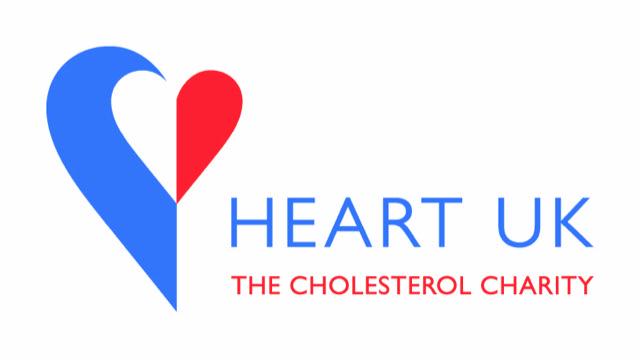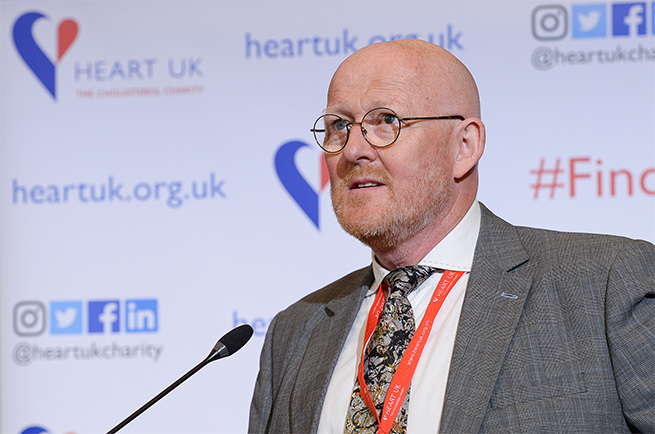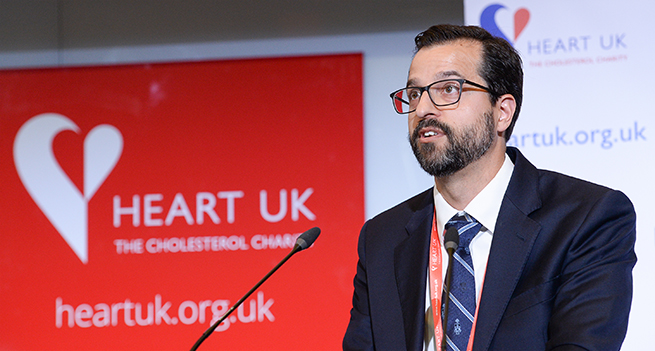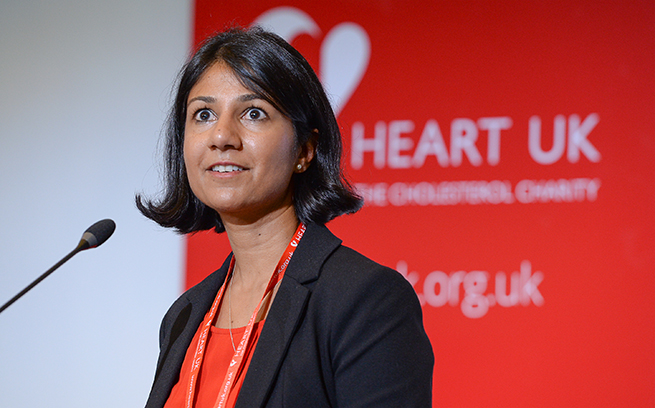HEART UK’s recent 35th Annual Medical Scientific Meeting blended a face-to-face meeting with virtual attendance to showcase the latest developments within the lipid community. Held at the University of Warwick on 6th–8th July 2022, Dr Andreas Tridimas reports its highlights.
The role of pharmacy

Dr Rani Khatib (Leeds Teaching Hospitals NHS Trust) outlined the scale of non-adherence in the secondary prevention of coronary artery disease (CAD) using a cohort of 503 patients with CAD. Non-adherence to at least one secondary prevention medication occurred in 43.5% of patients. Statins topped the list of non-adherance medications, contributing to 66.7% of overall non-adherence.1

To improve adherence, a novel joint cardiology pharmacist and cardiologist medicines optimisation clinic was established for patients discharged following myocardial infarction (MI). Here barriers to adherence were identified and discussed. Rates of non-adherence fell by 42.6%–70.8% three to six months post-clinic. Moreover, readmission rates also declined, suggesting this model may have a wider role in improving adherence.2 The pharmacy-led cardiology innovative medicines clinic provides better access to newer lipid-lowering therapies, helps in achieving low-density lipoprotein cholesterol (LDL-C) targets, and in tackling statin intolerance.
CVD risk and gender reassignment

Despite between 200–500,000 people in the UK identifying as transgender,3 Professor Devi Nair (Royal Free Hospital, London) highlighted that there is still not clear, high-quality evidence on how cross-hormone treatment influences long-term cardiovascular (CV) risk. Gender-affirming hormone therapy improves gender dysphoria and wellbeing in transgender patients, but the CV effects of such treatments are poorly defined due to the limited number of longitudinal studies focused on CV outcomes. To date, most studies have been observational, with heterogeneity of hormone regimens.4 Robust clinical evidence is needed to help manage CV risk in this population to avoid any potential health inequality.
Fats versus carbs

Professor Bruce Griffin (University of Surrey) reiterated the well-established notion that all forms of LDL-C are atherogenic and that, beyond doubt, higher LDL-C correlates with coronary heart disease risk.5,6 Thus caution, particularly when considering the paucity of long-term CV outcome data, is needed in relation to the lipid-modifying effects of certain diets, such as ketogenic low-carbohydrate, high-fat diets, whereby LDL-C may be seen to rise significantly.7
Statin myopathy and myositis

Severe myopathy with statin use remains very rare, Professor Hector Chinoy (Salford Royal NHS Trust) reminded delegates, telling them that keeping perspective is key given the proven ability of statins to prevent atherosclerotic complications.8 To assist clinical teams in determining whether muscle symptoms are likely to be statin related, he pointed the audience towards the Statin-Associated Muscle Symptom Clinical Index (SAMS-CI),9 which is a useful online tool for this purpose. In those found to have significant creatine kinase elevation with prior or current statin use, he discussed the rare presentation of statin-associated necrotising myopathy, an autoimmune condition, which can be assessed for with anti-HMGCR antibody testing. Positive anti-HMGCR antibody levels are strongly associated with this immune-mediated necrotising myopathy.10
CCTA in the lipid clinic

Dr Jonathan Rodrigues (Royal United Hospitals Bath NHS Foundation Trust) highlighted recent advances in CAD CV risk prediction. Traditional approaches such as coronary calcium scoring rely on the identification of coronary calcification, which represents the end stage of atherosclerotic disease. CAD, however, is an inflammatory process that can be detected far earlier by mapping the perivascular fat attenuation index, using coronary CT angiography (CCTA). Combining this information with traditional CV risk factors, technologies such as CaRi-Heart®, are poised to significantly improve our identification and risk stratification of CAD.11
Devolution differences
A session bringing together presenters from the four nations of the UK (Kate Shipman, Chichester; Paul Hamilton, Belfast; Sara Jenks, Edinburgh; and Yee Ping Teoh, Wrexham) outlined the regional variation in lipid management across the UK, highlighting some clear differences, most notably within familial hypercholesterolaemia (FH) identification. Northern Ireland is currently leading the way, with 23% of FH cases having been identified, followed by Wales at 14.5%, considerably above the UK average of under 8% identification. A key factor in achieving this success appears to be having dedicated FH nurses to work on cascade screening.
Lipoprotein(a): CV risk and emerging therapies
Professor Sam Tsimikas (University of California San Diego, USA) gave the latest updates on lipoprotein(a). He outlined how statins can significantly increase plasma lipoprotein(a) levels by approximately 8–24%, depending on the dose and statin used.12 Pelacarsen, an RNA-interfering injectable medication, has been shown in early studies to lower lipoprotein(a) levels by approximately 80%. Outcome data is not expected until 2025. Unlike previous therapeutics working via reducing ApoB production, hepatic steatosis does not appear to be an issue. At least four further drugs to lower lipoprotein(a) are in earlier stage trials and it is hoped all this research will lead to an effective treatment for reducing this risk factor for atherosclerotic vascular disease.
UK view

There is much regional variation in lipoprotein(a) testing, Dr Jai Cegla (Imperial College Healthcare Trust, London) told the meeting highlighting that, in their recent survey, 20% of lipid clinics reported they still did not offer its measurement. She directed the audience to the 2019 HEART UK consensus statement on lipoprotein(a), whose key statements included the recommendation to screen first-degree relatives of those with a raised serum lipoprotein(a) >200 nmol/L, due to the high CV risk conferred at such levels.13
Severe FH – from a lethal to a manageable disorder
The prestigious Myant lecture was given this year by Professor Frederick Raal (University of Witwatersrand, Johannesburg, South Africa), a titan within the FH community. He took the audience on a journey to show just how much progress has been made in the management of homozygous FH (HoFH). Professor Raal’s unit has one of the largest cohorts, if not the largest cohort, of HoFH patients in the world. From a previously lethal disorder in childhood, many of these patients are now adults with well-controlled cholesterol, through an array of lipid-lowering therapies, which are either LDL-receptor (LDLR) dependent or independent, depending on the residual LDLR function.

Professor Raal outlined how the arteries of a 20-year-old HoFH patient are exposed to same amount of cholesterol as a healthy 80-year-old individual. This highlights how it is crucial to start treatment early and continue this for life. Professor Raal finished his lecture with a promising look to the future. Could gene therapy eventually lead to a potential ‘cure’ for some with HoFH, by inducing LDLR expression in the liver, he asked?
Dr Andreas Tridimas
Consultant in Chemical Pathology and Metabolic Medicine
Countess of Chester Hospital, Chester
References
1. Khatib R, Marshall K, Silcock J et al. Adherence to coronary artery disease secondary prevention medicines: exploring modifiable barriers. Open Heart 2019;6:e000997. http://doi.org/10.1136/openhrt-2018-000997
2. Khatib R, Khan M, Barrowcliff A, et al. Innovative, centralised, multidisciplinary medicines optimisation clinic for PCSK9 inhibitors. Open Heart 2022;9:e001931. http://doi.org/10.1136/openhrt-2021-001931
3. Government Equalities Office. Factsheet: Trans people in the UK. Crown copyright 2018. ISBN: 978-1-78655-673-8 https://assets.publishing.service.gov.uk/government/uploads/system/uploads/attachment_data/file/721642/GEO-LGBT-factsheet.pdf (last accessed 3 October 2022)
4. Aranda G, Halperin I, Gomez-Gil E et al. Cardiovascular risk associated with gender affirming hormone therapy in transgender population. Front. Endocrinol 2021;12:718200 https://doi.org/10.3389/fendo.2021.718200
5. Borén J, Chapman MJ, Krauss RM et al. Low-density lipoproteins cause atherosclerotic cardiovascular disease: pathophysiological, genetic, and therapeutic insights: a consensus statement from the European Atherosclerosis Society Consensus Panel. Eur Heart J 2020;41:2313–30. https://doi.org/10.1093/eurheartj/ehz962
6. Ference BA, Ginsberg HN, Graham I, et al. Low-density lipoproteins cause atherosclerotic cardiovascular disease. 1. Evidence from genetic, epidemiologic, and clinical studies. A consensus statement from the European Atherosclerosis Society Consensus Panel. Eur Heart J 2017;38:2459–72 https://doi.org/10.1093/eurheartj/ehx144
7. Burén, J, Ericsson M, Damasceno NRT et al. A ketogenic low-carbohydrate high-fat diet increases LDL cholesterol in healthy, young, normal-weight women: a randomized controlled feeding trial. Nutrients 2021;13:814. https://doi.org/10.3390/nu13030814
8. Harper CR, Jacobson TA. The broad spectrum of statin myopathy: from myalgia to rhabdomyolysis. Curr Opin Lipidol 2007;18:401–8. https://doi.org/10.1097/MOL.0b013e32825a6773
9. Rosenson RS, Miller K, Bayliss M et al. The Statin-Associated Muscle Symptom Clinical Index (SAMS-CI): revision for clinical use, content validation, and inter-rater reliability. Cardiovasc Drugs Ther 2017;31:179–86. https://doi.org/10.1007/s10557-017-6723-4
10. Christopher-Stine L, Casciola-Rosen LA, Hong G et al. A novel autoantibody recognizing 200-kd and 100-kd proteins is associated with an immune-mediated necrotizing myopathy. Arthritis Rheum 2010;62:2757–66. https://doi.org/10.1002/art.27572
11. Oikonomou EK, Antonopoulos AS, Schottlander D et al. Standardized measurement of coronary inflammation using cardiovascular computed tomography: integration in clinical care as a prognostic medical device. Cardiovasc Res 2021;117:2677–90. https://doi.org/10.1093/cvr/cvab286
12. Tsimikas S, Gordts PLSM, Nora C et al. Statin therapy increases lipoprotein(a) levels. Eur Heart J 2020;41:2275–84. https://doi.org/10.1093/eurheartj/ehz310
13. Cegla J, Neely RDG, France M et al. HEART UK Medical, Scientific and Research Committee. HEART UK consensus statement on lipoprotein(a): A call to action. Atherosclerosis 2019;291:62–70. https://doi.org/10.1016/j.atherosclerosis.2019.10.011
